New Zealand - Rotorua
Day 3 and Day 4 - Rotorua
From Waitomo, we headed towards Rotorua - the heartland of Maori culture - and were there by evening. According to locals, Rotorua is the only place in New Zealand where you can tell exactly where you are with your eyes closed, courtesy the distinct smell of sulphur from the hot springs and boiling mud pools that are found in plenty. However, we didn't really sense the smell too strongly. What we did sense was the immense cold though. It was the coldest weather we had experienced so far. Seriously, wasn't it supposed to be summer and all that? Fortunately, our hotel had a thermal pool and we spent a relaxing half hour before heading for dinner.

The view from our hotel room

We went for a drive around the hotel to look for a dinner place, and clicked some awesome night view shots.

Another view

Viv wanted me to take this shot, and I must say it turned out pretty well.
We had yummy Indian dinner at this restaurant called Tandoori Palace. The day had come to an end. It had been a long day of driving, and we had a lot to do the next day.
The next morning was bright and sunny, and yet very very cold. We were headed towards the Te Puia region to view the hot springs, boiling mudpools and Maori culture. About 35% of Rotorua's population are Maori, and the place attracts 1.6 million visitors annually. Te Puia, named after the 'pa' or Maori fort that protected the valley and its people is a significant Maori cultural centre that boasts of hot geysers, boiling mudpools, a kiwi conservation centre, weaving and carving schools and a daytime Maori concert.

I pose at the entrance of Te Puia.

Viv poses at the bridge leading to the thermal geysers.
Our guide taught us the Maori greeting 'Kia Ora' before leading us through the thermal valley.

Our guide shows us reconstructed Maori huts.

Animal skins hanging to dry outside the Maori huts
Our guide was demonstrating how the Maori people made ropes from leaf fibres. She plucked a long leaf from a palm tree, scraped it with a mussel shell, and asked one of the tourists "May I borrow your leg?" As the shocked tourist scurried off to the back of the crowd, the guide laughed and asked another guy. She then rubbed the leaf fibres between her hand and his leg, and made this perfect rope. It was totally amazing!

Our guide with the fibre rope

Valley of hot geysers

The Waikorohihi geyser can shoot water up to 5 metres high.

Sulphur laden smoke coming out of the fissures in rocks

The thermal valley

One of the geysers had suddenly started erupting and our guide was using her walkie talking to alert all the other guides about it. Water was shooting out and going really high. Our guide told us that the temperature of the water was close to boiling point!

I pose beside the erupting geyser.

A closer look at the eruption
We then moved on to walk around the place view the boiling mudpools.

The walk was a long one, and we took breaks to click pictures.

Viv poses against the valley.

Finally, the boiling mudpools!
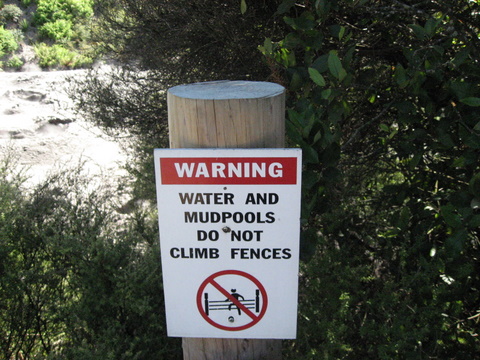
I couldn't stop laughing when I saw this sign. Too philosophical if you think about it! :)

Later, we went to have a look at their carving school, where artists were making beautiful Maori carvings from large logs.

Viv poses against this inspiring structure, made entirely of wood.
Next in line was the Maori concert for which we were asked to remove our shoes as a sign of respect.

The concert hall
A leader was chosen to represent our 'tribe' - the tourists. The 'powhiri' or 'traditional welcome' started with the Maori warrior - dressed in traditional Maori clothes - doing a war dance. This dance is supposed to scare off enemies. The warrior then placed a leaf on the ground as an offering of peace to our leader. The our leader picked up the leaf as an acceptance of the welcome.

The Maori women came out of the hall singing the welcome song.

This was followed by a dance by the entire tribe.

A close-up of the Maori people

Inside the concert hall

The ferocious Haka - the male war dance

Check out the guy on the left!
The concert included native songs and dances, such as the poi dance where the skilful females moved fibre balls suspended by threads in rapid circular motions, action songs also known as Waiata a Ringa, and stick games known as Tititorea and Ti rakau. After the concert, we went to the gift shop and bought souvenirs including soap made from the mud of the boiling mudpools.
Our next destination was Paradise Valley springs - home to native flora and fauna, including the famous rainbow trout. It was a very large, beautiful and natural area, full of greenery.

Near the entrance

We'd bought some food to feed the trout, but I gave a lot of it away to this very hungry sparrow.

Random bird that Viv clicked

Aha, we spot a trout!

Viv took this AMAZING shot of a fern.

Oh deer!

Check out the size of the antler!

Darn I forgot the name of this animal!

Another lake with colourful trout

This was taken through the glass in the underground viewing gallery.

Hungry duck diving for food

Check out the amazing feathers on these ducks

Wallaby, a cousin of the kangaroo

Another shot of the wallaby

The hungry duck that followed me into the wallaby enclosure
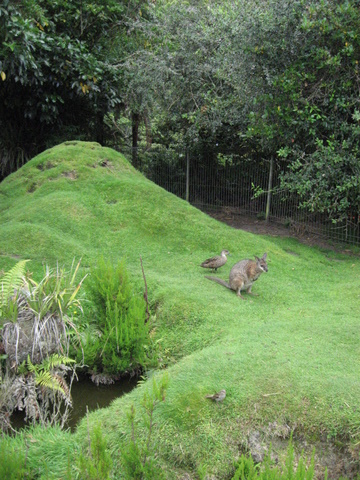
Wallaby, duck and sparrow

Random guy's hand and wallaby

I wander through the valley.
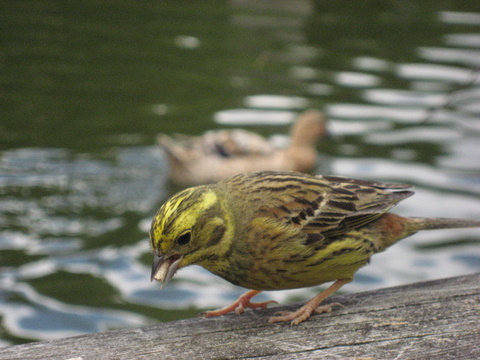
Another excellent shot by Viv of this yellow bird that kept following us

Black swans

Emu

Pigs


Two members of the llama family

I'd never seen a sheep like this in real life - only in pictures and on TV.

Cool horns, eh?

The grand lion family
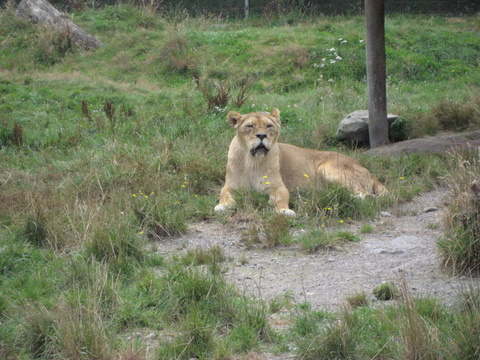
This one looks bored.

Finally, a majestic pose!
After this, we were off to watch the Agrodome farm show.

It was one of the most picturesque journeys we'd had so far.

The day was bright in spite of being a cloudy one.
As we drove on, we suddenly saw a police car behind us. It didn't ask us to stop, but just kept following us for a good twenty minutes. At fist, I freaked out but later realised that it was just headed the same. But Viv said it can be quite nerve-wracking if you're leading the way for a police car, and you gotta be ultra careful about how you're driving. Good thing he was on the wheels, and not me.

But I neatly caught the police car in the mirror!

More amazing sights

Something tells me we're close to the farm...

And we reach Agrodome!

The show started with the shearer introducing us to 19 different types of sheep!
Then he asked us to pick the sheep to be sheared. We picked the one with the thickest fur.

Making the sheep smile (this is also the 'before' picture)

The shearing process

The 'after' pic
After shearing, he passed around some pieces of wool for us to see.
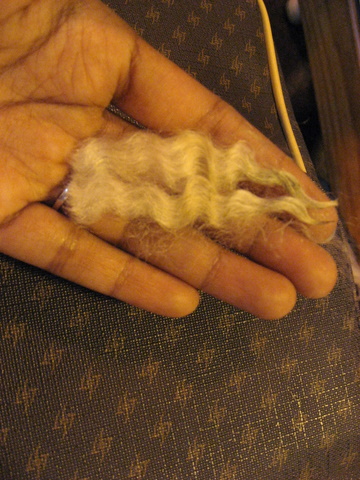
I examine the wool.
Then he said that he was gonna auction one of the sheep, and that any movement - any movement at all - would be considered a bid. So as we tried to be perfectly still, the kid couldn't take it and moved, and immediately the shearer declared that the sheep was 'sold' to the kid. The amused kid was invited on the stage and the shearer asked him if he was ready to take one of the 19 sheep home.

The poor kid was so nervous he started smiling and looking at his mother in the audience. To his relief, he was given a tiny model of a sheep and sent back.
Next, the shearer asked some people from the audience to help him milk a rather large cow. He held up two buckets and asked us what we thought the second bucket was for.
"To SIT." We yelled out.
"Sit?? Nope. But it does rhyme with 'sit'!" He guffawed.
Ohhhhhhhhhh! :D

While three managed just fine, when the fourth volunteer tried, there was no milk. The shearer made a startled face and exclaimed, "You broke my cow???!!" sending the kids into peals of laughter.

The sheep decided to take a nap as the cow was being milked.

Next was the sheepdog demonstration, which was done using two ducks instead of sheep to maintain discipline on stage. The dog effortlessly rounded up the ducks.

The dogs climb atop the sheep and the sheep do not protest!

More volunteers were invited to feed the very hungry lambs.

At the end of the show, I posed with the napping sheep.
Outside the show area was an old shearing shed with loads of pictures and newspaper cuttings of world-famous shearers. It seems there are world records for the number of sheep sheared in one working day, and people can apply if they want to attempt to break it.

Outside the shearing shed
After the show, we drove towards the area where people were zorbing. The zorb is a large ball used for a strange activity. People get inside these water-filled balls, which are then rolled down slopes. If the balls were not filled with water, I'd have zorbed too, but I can't stand the thought of my head being under water.

Check out the zorbs!

A little distance away, there was a crane bungy.
I took a video of a guy leaping off the crane (you'll find it in the NZ - videos link), and we headed back to the hotel to freshen up for the Maori concert at night.
That evening, a bus came to pick us up and take us to Tamaki village for another Maori concert. Our guide Mark was the funniest New Zealander we'd ever met. He greeted us in 59 different languages including Hindi, mimicking the accents of all! He kept cracking jokes throughout the journey till we had reached. As had happened in the morning, he also selected a leader to lead our 'tribe'.

Mark the bus driver and guide

Once we reached the village, we waited at the entrance, while this cute dude gave us instructions on protocol.

Maori warrior standing on top of the village gate

Haka war dance

Another Maori warrior trying to scare us off...
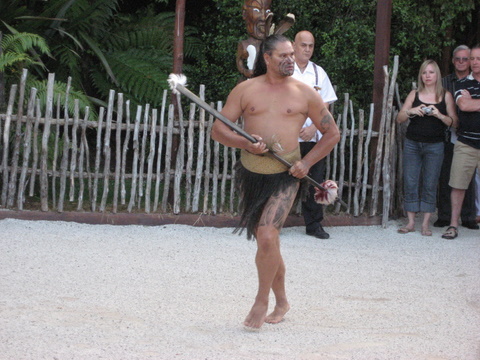
... and yet another!
Finally, the peace offering was accepted and the Hongi was performed. The Hongi is the typical Maori greeting in which the two people greeting each other press their noses twice. It is said that the meeting of the breaths bonds them in friendship.
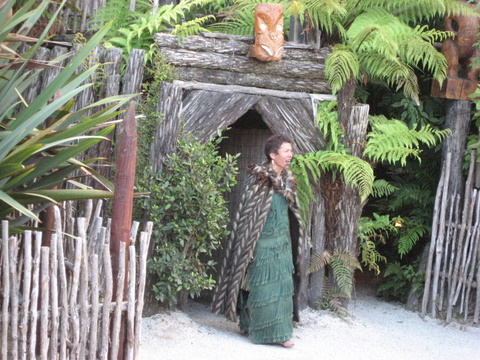
The women sing the welcome song.

Models of Maori huts had been set up, with Maori villagers doing their daily tasks. Though it was freezing cold, the men were topless. I asked one of the women (they wore long dresses made of skin, fur and feathers) how the men stood the cold, and she winked and said, "They're cold too. They just want to show off their bodies."

What a body to show off, huh?

We were taken into the concert hall and the performance started. It was a tad startling to see a half-naked Maori guy play the guitar, but we soon got used to it.
Afterwards, dinner cooked in the traditional Hangi way was served. One of the guides explained the Hangi method to us. Rocks are heated to a white hot state using a timber fire, and then put in a pit dug in the earth. Baskets of meat are put directly over the hot stones, followed by baskets of vegetables such as the kumara (a cousin of sweet potato and a Kiwi delicacy), and finally the pudding basket is placed on top. A wet cloth is placed over the food. Earth is piled over everything and the food is left for three to four hours.

"You put the meat, the vegetables, and the Australians into the pit of hot stones" our guide joked as he described the Hangi process.

We found a packet in the gift shop with the words "Kiwi Poo"!
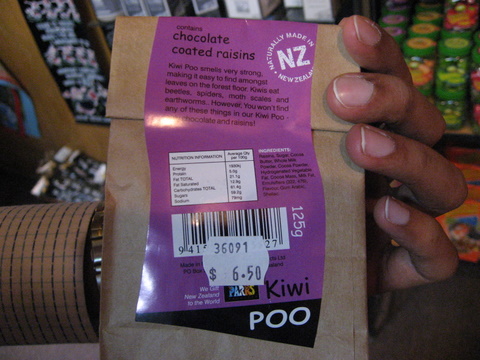
Luckily, they were only referring to chocolate coated raisins!

Final shot of the day - where I stood next to the bonfire to get some respite from the bitterly cold weather.
Next up - Wellington
From Waitomo, we headed towards Rotorua - the heartland of Maori culture - and were there by evening. According to locals, Rotorua is the only place in New Zealand where you can tell exactly where you are with your eyes closed, courtesy the distinct smell of sulphur from the hot springs and boiling mud pools that are found in plenty. However, we didn't really sense the smell too strongly. What we did sense was the immense cold though. It was the coldest weather we had experienced so far. Seriously, wasn't it supposed to be summer and all that? Fortunately, our hotel had a thermal pool and we spent a relaxing half hour before heading for dinner.

The view from our hotel room

We went for a drive around the hotel to look for a dinner place, and clicked some awesome night view shots.

Another view

Viv wanted me to take this shot, and I must say it turned out pretty well.
We had yummy Indian dinner at this restaurant called Tandoori Palace. The day had come to an end. It had been a long day of driving, and we had a lot to do the next day.
The next morning was bright and sunny, and yet very very cold. We were headed towards the Te Puia region to view the hot springs, boiling mudpools and Maori culture. About 35% of Rotorua's population are Maori, and the place attracts 1.6 million visitors annually. Te Puia, named after the 'pa' or Maori fort that protected the valley and its people is a significant Maori cultural centre that boasts of hot geysers, boiling mudpools, a kiwi conservation centre, weaving and carving schools and a daytime Maori concert.

I pose at the entrance of Te Puia.

Viv poses at the bridge leading to the thermal geysers.
Our guide taught us the Maori greeting 'Kia Ora' before leading us through the thermal valley.

Our guide shows us reconstructed Maori huts.

Animal skins hanging to dry outside the Maori huts
Our guide was demonstrating how the Maori people made ropes from leaf fibres. She plucked a long leaf from a palm tree, scraped it with a mussel shell, and asked one of the tourists "May I borrow your leg?" As the shocked tourist scurried off to the back of the crowd, the guide laughed and asked another guy. She then rubbed the leaf fibres between her hand and his leg, and made this perfect rope. It was totally amazing!

Our guide with the fibre rope

Valley of hot geysers

The Waikorohihi geyser can shoot water up to 5 metres high.

Sulphur laden smoke coming out of the fissures in rocks

The thermal valley

One of the geysers had suddenly started erupting and our guide was using her walkie talking to alert all the other guides about it. Water was shooting out and going really high. Our guide told us that the temperature of the water was close to boiling point!

I pose beside the erupting geyser.

A closer look at the eruption
We then moved on to walk around the place view the boiling mudpools.

The walk was a long one, and we took breaks to click pictures.

Viv poses against the valley.

Finally, the boiling mudpools!

I couldn't stop laughing when I saw this sign. Too philosophical if you think about it! :)

Later, we went to have a look at their carving school, where artists were making beautiful Maori carvings from large logs.

Viv poses against this inspiring structure, made entirely of wood.
Next in line was the Maori concert for which we were asked to remove our shoes as a sign of respect.

The concert hall
A leader was chosen to represent our 'tribe' - the tourists. The 'powhiri' or 'traditional welcome' started with the Maori warrior - dressed in traditional Maori clothes - doing a war dance. This dance is supposed to scare off enemies. The warrior then placed a leaf on the ground as an offering of peace to our leader. The our leader picked up the leaf as an acceptance of the welcome.

The Maori women came out of the hall singing the welcome song.

This was followed by a dance by the entire tribe.

A close-up of the Maori people

Inside the concert hall

The ferocious Haka - the male war dance

Check out the guy on the left!
The concert included native songs and dances, such as the poi dance where the skilful females moved fibre balls suspended by threads in rapid circular motions, action songs also known as Waiata a Ringa, and stick games known as Tititorea and Ti rakau. After the concert, we went to the gift shop and bought souvenirs including soap made from the mud of the boiling mudpools.
Our next destination was Paradise Valley springs - home to native flora and fauna, including the famous rainbow trout. It was a very large, beautiful and natural area, full of greenery.

Near the entrance

We'd bought some food to feed the trout, but I gave a lot of it away to this very hungry sparrow.

Random bird that Viv clicked

Aha, we spot a trout!

Viv took this AMAZING shot of a fern.

Oh deer!

Check out the size of the antler!

Darn I forgot the name of this animal!

Another lake with colourful trout

This was taken through the glass in the underground viewing gallery.

Hungry duck diving for food

Check out the amazing feathers on these ducks

Wallaby, a cousin of the kangaroo

Another shot of the wallaby

The hungry duck that followed me into the wallaby enclosure

Wallaby, duck and sparrow

Random guy's hand and wallaby

I wander through the valley.

Another excellent shot by Viv of this yellow bird that kept following us

Black swans

Emu

Pigs


Two members of the llama family

I'd never seen a sheep like this in real life - only in pictures and on TV.

Cool horns, eh?

The grand lion family

This one looks bored.

Finally, a majestic pose!
After this, we were off to watch the Agrodome farm show.

It was one of the most picturesque journeys we'd had so far.

The day was bright in spite of being a cloudy one.
As we drove on, we suddenly saw a police car behind us. It didn't ask us to stop, but just kept following us for a good twenty minutes. At fist, I freaked out but later realised that it was just headed the same. But Viv said it can be quite nerve-wracking if you're leading the way for a police car, and you gotta be ultra careful about how you're driving. Good thing he was on the wheels, and not me.

But I neatly caught the police car in the mirror!

More amazing sights

Something tells me we're close to the farm...

And we reach Agrodome!

The show started with the shearer introducing us to 19 different types of sheep!
Then he asked us to pick the sheep to be sheared. We picked the one with the thickest fur.

Making the sheep smile (this is also the 'before' picture)

The shearing process

The 'after' pic
After shearing, he passed around some pieces of wool for us to see.

I examine the wool.
Then he said that he was gonna auction one of the sheep, and that any movement - any movement at all - would be considered a bid. So as we tried to be perfectly still, the kid couldn't take it and moved, and immediately the shearer declared that the sheep was 'sold' to the kid. The amused kid was invited on the stage and the shearer asked him if he was ready to take one of the 19 sheep home.

The poor kid was so nervous he started smiling and looking at his mother in the audience. To his relief, he was given a tiny model of a sheep and sent back.
Next, the shearer asked some people from the audience to help him milk a rather large cow. He held up two buckets and asked us what we thought the second bucket was for.
"To SIT." We yelled out.
"Sit?? Nope. But it does rhyme with 'sit'!" He guffawed.
Ohhhhhhhhhh! :D

While three managed just fine, when the fourth volunteer tried, there was no milk. The shearer made a startled face and exclaimed, "You broke my cow???!!" sending the kids into peals of laughter.

The sheep decided to take a nap as the cow was being milked.

Next was the sheepdog demonstration, which was done using two ducks instead of sheep to maintain discipline on stage. The dog effortlessly rounded up the ducks.

The dogs climb atop the sheep and the sheep do not protest!

More volunteers were invited to feed the very hungry lambs.

At the end of the show, I posed with the napping sheep.
Outside the show area was an old shearing shed with loads of pictures and newspaper cuttings of world-famous shearers. It seems there are world records for the number of sheep sheared in one working day, and people can apply if they want to attempt to break it.

Outside the shearing shed
After the show, we drove towards the area where people were zorbing. The zorb is a large ball used for a strange activity. People get inside these water-filled balls, which are then rolled down slopes. If the balls were not filled with water, I'd have zorbed too, but I can't stand the thought of my head being under water.

Check out the zorbs!

A little distance away, there was a crane bungy.
I took a video of a guy leaping off the crane (you'll find it in the NZ - videos link), and we headed back to the hotel to freshen up for the Maori concert at night.
That evening, a bus came to pick us up and take us to Tamaki village for another Maori concert. Our guide Mark was the funniest New Zealander we'd ever met. He greeted us in 59 different languages including Hindi, mimicking the accents of all! He kept cracking jokes throughout the journey till we had reached. As had happened in the morning, he also selected a leader to lead our 'tribe'.

Mark the bus driver and guide

Once we reached the village, we waited at the entrance, while this cute dude gave us instructions on protocol.

Maori warrior standing on top of the village gate

Haka war dance

Another Maori warrior trying to scare us off...

... and yet another!
Finally, the peace offering was accepted and the Hongi was performed. The Hongi is the typical Maori greeting in which the two people greeting each other press their noses twice. It is said that the meeting of the breaths bonds them in friendship.

The women sing the welcome song.

Models of Maori huts had been set up, with Maori villagers doing their daily tasks. Though it was freezing cold, the men were topless. I asked one of the women (they wore long dresses made of skin, fur and feathers) how the men stood the cold, and she winked and said, "They're cold too. They just want to show off their bodies."

What a body to show off, huh?

We were taken into the concert hall and the performance started. It was a tad startling to see a half-naked Maori guy play the guitar, but we soon got used to it.
Afterwards, dinner cooked in the traditional Hangi way was served. One of the guides explained the Hangi method to us. Rocks are heated to a white hot state using a timber fire, and then put in a pit dug in the earth. Baskets of meat are put directly over the hot stones, followed by baskets of vegetables such as the kumara (a cousin of sweet potato and a Kiwi delicacy), and finally the pudding basket is placed on top. A wet cloth is placed over the food. Earth is piled over everything and the food is left for three to four hours.

"You put the meat, the vegetables, and the Australians into the pit of hot stones" our guide joked as he described the Hangi process.

We found a packet in the gift shop with the words "Kiwi Poo"!

Luckily, they were only referring to chocolate coated raisins!

Final shot of the day - where I stood next to the bonfire to get some respite from the bitterly cold weather.
Next up - Wellington
Labels: New Zealand

